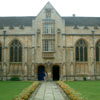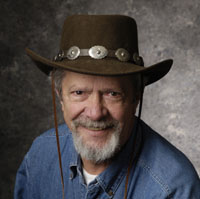The SMU-in-Oxford Experience
Anthropology Prof. Ronald Wetherington writes about the heady experience of teaching at SMU-in-Oxford.

Oxford, England, is a town whose center properly belongs to centuries past. Its cobbled streets unfriendly to bicycle tires and ladies in heels, its ancient stone buildings not readily welcoming today’s water and electrical utilities, its storm sewers not always equal to the challenge of heavy downpours, it does not languish in its antiquity, but rather embraces it. The university system here was established in the 12th Century—the third oldest in Europe after Bologna and Paris—and consists now of 38 colleges. The oldest is University College (known locally simply as “Univ”).
 Prof. Ronald K. Wetherington |
It is in this college that, each summer, seventy-plus SMU students convene for five weeks of learning from both SMU and Oxford faculty. And it is here that they become absorbed into the past, enveloped by its architecture and engaged by its ceremonies. Thus cosseted, they give testimony to William Faulkner’s observation, “The past isn’t dead; it’s not even past.”
This was my first summer to teach at Oxford, a course on “Concepts of Evolution”—a history of the idea both preceding and following Charles Darwin. It was, of course, propitious, 2009 being the bicentennial of his birth and the 150th anniversary of the publication of his world- transforming “On the Origin of Species.” The landscape helped teach the course: a visit to Down House, Darwin’s home and laboratory in Kent, revealed the carnivorous plants, hybridized flowers, and famous “worm-stone” which fed the immense curiosity of this man. At the Oxford Museum, we were allowed into the now-closed hall where the famous Huxley-Wilberforce “debate” occurred in 1860, between Bishop Samuel Wilberforce, opposing Darwin’s idea, and Thomas Henry Huxley, “Darwin’s bulldog” and defender.
The hall has been long closed, with an upper floor now dividing the original vaulted height and providing space for the impressive insect and spider collection (second only to that in London’s Natural History Museum). Darren Mann, the museum’s manager of entomology, delighted in showing us specimens collected over 150 years ago by Darwin himself and his co-discoverer of the principle of natural selection, Alfred Russell Wallace. Mann’s enthusiasm and our child-like wonder made this a defining experience.
In London, our class visit to the Natural History Museum—mere blocks from the students’ weekend residence in Imperial College—presented more delights, including a recent ancient primate skeleton which is helping to clarify our own ancestral lineage. Its new Darwin Exhibit Hall was not due to open until after our return to Dallas.
The heady experience of Oxford was made even more memorable with the happy convergence of the writings we read and discussed with the very places their authors lived and the footpaths they travelled. Here were Roger Bacon, one of the earliest advocates of experimental science, receiving his Master’s at Oxford in A.D. 1240; William Harvey, who first detailed the circulation of blood, becoming a dean at Oxford in 1644; the revolutionary philosopher John Locke, with degrees at Oxford beginning in 1656; Robert Hooke, first observer of the cell, in Oxford in 1653, and his colleague Robert Boyle, inventor of the vacuum pump—these two having adjacent laboratories at Univ in the space where the monument to infamous poet Percy Bysshe Shelley now resides.
It is such intellectual intoxication—this immersion in the history of discovery—that few of us experience in our education and in our careers, and more’s the pity! All of us felt a sadness upon leaving, reluctant to give up our recently discovered past. But this past has now become imbedded in each of us, prepared unannounced to occasionally seep into the present.
# # #